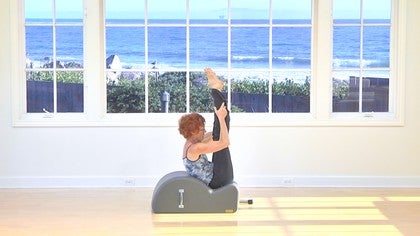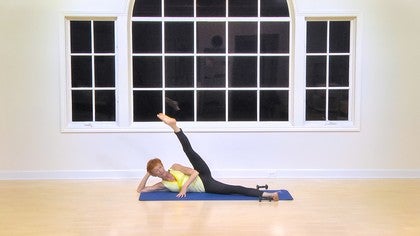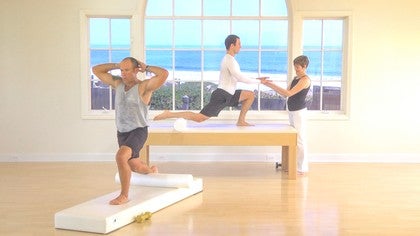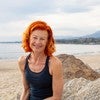Description
About This Video
Transcript
Read Full Transcript
Good evening everybody. I'm going to do a spine corrector workout this evening inspired by the math work and I am using a grants spine correctly, which is a little bit wider and narrower and also more shallow, which gives it a little bit more of a softness to the work. But all of this work can be adapted to any spine correctly. You happen to have it use studio and um, the benefit of these, the arts, whether it's a small arc or this would be the spine correctly or medium mark or the bally, uh, the high bar, the latter barrel, which is a high bar, is that the art king part can be used to deal with areas of the body that are far more congested. So let's say the rib cage has a tendency more tight and possibly more close.
So by placing pressure right into the center where the back is more rounded, you can start to open up and put the forces of pressure differently into the area. The same would apply for the pelvis, the pelvis. Sometimes people can have the hip flexors tight, maybe the lower back is tight. So by elevating the pelvis and laying the sacrum. Exactly right. You can open it further and I'll be talking more about it in the lesson. So, or in this demonstration I should say. So just to start with the open up, my upper back, I'm laying down, now I'm securing my sacrum is or [inaudible] pounds a just over the edge. But more important than that, I'm placing the pinnacle of the barrel more or less across the top part of my body and then lifting the arms up to the ceiling and just once or twice lifting and lowering the shoulders to get a sense of where the shoulders are, keeping the rib cage down. Then still keeping the neck long, reaching out.
So I get openness into the armpits and bringing the arms down. So I'm going back and forth and put I focusing on right now with not releasing the ribs, which will naturally make more openness. Right now I'm letting go of my ribs, but seeing if I can contain them so that the spinal structure is stable and throwing the focus more directly into the armpits and elongating the triceps, elongating the arm bones out to allow them to warm up and loosen up. And it's really a lovely, lovely feeling to be doing this, to get this kind of expansiveness starting to happen with the support of the barrel and then lifting my head coming up. I'm going to start from here, going into the hundreds. So with the sacred [inaudible] over, I'm allowing the trunk to belong. I'm not over lifted or, and there's a nice cuddling feeling that comes into this because once the knees are up, I'm allowing my lower back to really lengthen out and feeling the support, extending the legs out at whatever angle I feel is nice for me and I'm starting my pumps now. The beauty of the shape that I'm going into right now is that I can actually feel my lower back being traction. So though someone's taking my sacrament, stretching it away.
And at the same time I do feel that my stomach muscles are working to support me and I'm going to take a few deep breaths just to be really legal and kosher. About this hundred exercise. I'm taking a breath in and a breath out and a breath in and a breath out. And sometimes when I have clients I will work them a little bit further back so the focus can really work deeply into the center of the powerhouse, bending the knees in, giving myself a bit of an extra stretch and this is beautifully giving me a nice sensation of a stretch into my lower back and coming up. So here again, I'm starting my roll back for the roll up. So first time I work with my knees, bend, lifting my head and seeing if I can roll up.
Now my sit bones are over the edge, so I really have to hold with my stomach not to fall off the spine. Correct. So it's truly allowing me a very interesting angle and challenge into the roll up that is very stimulating and more detailed as far as my work goes. And one more time rolling up with this variation and then rolling back down. Now from here I'm going to move a little bit further back, so now my hips are in front and I'm going a little bit further so I can actually come up and then stretch over. This one is a lovely, lovely variation, especially for people who are tight in the hamstrings because they can barely get up and this allows extra links into the hamstrings, extra length into the back, and because this specific spine corrector is longer, it just starts massaging the spine a little bit further and letting that area of the ribs, which gets very, very tight to start to relax a little bit and open up.
Now, the other thing is that I am slightly releasing my ribs here into in order to allow that openness to come into the chest. But on the way up, I'm gathering these ribs together, again, gathering into the center of the spine, lifting up, and then scooping to go over to get that length coming in. Then I'm going to move back for an extra little bit. Take the uh, the stick here again and roll back through. Now I'm actually going into the RQ movement where I allow the ribs to open, taking my arms back and, but peeling in to come up and lifting up. So on many levels, this is providing me with a huge amount of variety of roles into the back, into the spine and into the stomach. And it starts to relieve a huge amount of tension, which feels delicious, Lee. Nice. Now from here, going into roll over, sitting at the top, very important because usually people fall down. So with one foot here, grabbing on here, I make sure my bottom is still in front of the pinnacle so that as I roll back my pelvis is weighted towards the legs.
I can find the floor and then I can lie down just enough to get my shoulders and head on the floor. Then lifting the legs up in the air. From here I'm tightening my hips and rolling away from the barrel towards the floor, pressing, pressing Ang incurring the pelvis on and then doing the work with the leg. So again, lifting the hips, allowing the hips to come off and rolling back up. So this one on the reformer roll over is considered the parallel to short spine massage and the reformer. And I have to say that on the barrel it truly feels like a massage, not only into the lower back, but oddly enough the position of the hips and the way the hands hold is actually opening up my shoulders in a beautiful way, an area that gets tight for me and coming back up. Now from here, I'm checking that my sacraments really nicely secure.
Dropping one leg down for single leg circles. I'm checking that the hips a square and the first time I'm just going to do the circles with the one leg bent as that is usually where most people can start. As I do this, if I'm self protecting myself, I'm checking that my hip bones are nice and even, and then to help open up the hips and the hip flexors, I'm just taking a few times down and up with this sleigh to get this opportunity to get into this opening into the front of the leg. While the sacrum is nice and long, repeating the same thing with the other leg. I'll just do three circles one way, checking to make sure that there's no instability in the pelvis and then I'm lengthening the legs out, opening up into the hip flexor.
This always feels so good on my body because I have a tendency to get grippy in there. Now I'll go for the next variation, which is a more advanced one and the one that really allows a hip flexes to open nicely. I'm not that open on this side, but the leg goes down. I'm just reaching it long and now I have to really stabilize my sacred because if I didn't, I know I'd be flying all over the place. So this is really a nice challenge circling the other way and it also allows me to focus on pressing my sacred up into the center of my body, bending and lifting the other leg up and lengthening this leg out. Lot of length and width. It's like someone's taking the hipbones and tractioning them sideways and the sacrum is being pressed up. I'm not tucking I, I'm just pressing it straight up.
So there's like this platform and this low part of the abdomen up, which is an area, again that gets grippy and tight and possibly twisted for many people because of pelvis is such a crossroads of energetics with the legs coming up, the upper body weighing down. It's really an interesting area that has to do a lot of different types of jobs and then to come back up, this is the fun part for advanced people. Take the legs over, hips come up and Voila, here I am, I've come back. I always love doing that. So from here, the fake from his little bit over the edge, I'm lying back, making sure literally to create this lengths in the lower back for single leg stretches and lovely, lovely plate for the lower back to feel cradled and open and supported at the same time. And if I wanted to add more stretch I would take that leg and lengthen it down. Lengthen it down. So again, it's opening up the hip flexors in the front and challenging this high wide part of the leg with very seldom gets to be worked in a very detailed way.
Double leg stretches first I check that my lower back is long stretching out to twice. I'll do simple version and now I'm going to add the benefits of having the spine corrector. Here I am an anchoring and I'm opening the chest so my lower body has to be locked, my hips have to be locked and then without losing the lock I get to open my chest. One more time. Hips, a locked chest is open, arms are being challenged to go back, coming up and going right into scissors and the focus here is very much this lower leg being asked every time. Reach further out, further out and further out. Lower lift, lowering down, keeping that lower spine long. And if I wanted to add, I could go back, go up and lift lower, go back, go up and lift going into criss-cross, lovely place to be anchored because the lower pelvis is so nicely locked into position, it allows me to work my stretch little bit further and stretch and coming up with spine stretch forward.
Beautiful place to do this because the legs are much lower than the hips and it gives an opportunity for people who are very tight to actually get the benefit of the stretch where you curl down and retreat to the floor. So right here there's this lovely place to open up here and wiggle the fingers forward. Getting as much of a stretch. I happened to be very flexible so I can kind of work into my own range. [inaudible] a lot of people who are tighter, they work with the knees bent, but it actually lets them get into this lumbar spine and open it up and maybe they can only go a smaller amount, but they usually get a lot more out of doing it on the spine corrector than they do doing it on the floor, especially if they are tight now open, like Drucker, it's fun because I've anchored my hips back or I should say the sit pounds are just in front of the ledge and now I have to work my balance, which is a lot more challenging in this place and I can even work. Oh yes, definitely. Much more challenging.
Oh, here we go. Now I only have a small rock before I have to come back up and definitely I have to work in a very detailed way into my lower spine. This definitely doesn't look half as dramatic as the one on the floor, but I have to say for someone like me, I'm getting a whole lot more of a workout doing it here than I do on the floor. Come on the Edra. Let's see if I can lift up. Yes, very [inaudible]. You can really see how in my body there's a certain amount of collapsing that happens in the lower back that I get to work on when I'm being challenged this way. Okay, so that's good enough.
Let's see if I can balance here. Okay. I'll call that one quits even though I would like to stay around in play with that when usually when I can't do something, it fascinates me to spend more time there. So going on from here into corkscrew again, one foot up, one foot down and rolling their own onto them. The floor with the shoulders down and the legs up. So nice stability of the hips and circle the legs around.
So the first set, I am literally just staying with weight on both hips, even though there's a shift now I'm letting one hip come up over and one hip down, around and up, and now I'm going all the way up, anchoring, anchoring, lifting, and then reverse anchoring, anchoring, lifting. And now I'm lowering and going right into the leg circles that we normally do. Seeing I'm already here. Getting those hips that have been being warmed up open and then reversing it and over and then going into my scissors again, using the opening into the hip flexors that I was working. So the focus now is on the leg that's going towards the ledge, going into the bicycle, reaching out from the hip, reaching out from the hip, reaching out from the hip, reaching out from the hip, and then reversing it, pressing out per a thing out, pressing out, pressing out, pressing out and pressing out. And then one more time, lower lift, lengthening and lengthening and lengthening and adding on to this, the one where you roll over onto your hips, onto your head.
So you roll length in the legs down and pop up onto the head. So I'm working to open the chest, opening the legs down, hips up, anchoring onto the hips and lifting, opening the legs out. So you could almost say this is a sophisticated variation of roll over. Now we're versing it, opening the legs, opening the legs out and up. And one more time, legs go out and up.
And then coming back to a sitting position. I'm taking the hips over and coming up. So if you notice, I pull the spine corrector in towards my body a little bit in order to pull myself up. Cause a lot of these exercises you do, it is like piece of apparatus. You just sit a little bit here and there and the most sophisticated ones so it actually supports your body the right way. So there's no rule or regulation that's an absolute, these are very much adjustments that have to make it work on your body with the correct principles in mind. So from here, moving back to saw, so I am sitting back of the ledge.
The back is long twisting and stretching. So I'm using this to get the length all over the leg. And what's lovely with the way I'm sitting is it allows the anchoring of the hips to be very clear. So whoever's doing the exercises, getting direct feedback that their pelvis is nice and stable. One more time and my last one and coming back up and now coming over for Swan. So I'm making sure my hips are lifted and just checking first of all that I can rock down and come back up.
So this is a nice place actually to get the feedback and the support while I'm going for the rocks and my legs are in the air, my stomach is long, my back is long legs, rock, chest, rocks, up, legs, rock up, chest, legs and chest. And moving back a little bit. Going into single leg kicks definitely is making my hamstrings work. A lot of people's feet cramp and then I'll have them work with flexed feet. Moving back a little bit so the knees are over the edge so I can lift my hands off the floor, kick to three and lifting the chest up and again, kick to three lifting up. So as I'm not lying on the floor, I do not have to turn my head to one side.
And this is nice and challenging because I have to really work a lot on my balance. This is not just for stability, it's a lot of upper and lower body's staying in relation to each other. I'm now moving a little bit further back for rocky, one of those ones which are moment of truth because the naval point has to be placed just right and you can't. Um, the upper body and lower body have to be in relationship. So very flexible. People have to work very differently from stiff people because you have to, you can't go too far in one direction or the other. You have to find this point where you can be balanced and then go for the rock. Actually a wonderful one for flexible people because they used to being able to do things and not have a lot of control because they relying on the range of movement.
But on this one they flexibility can actually be a deterrent because of this fall over stretching back, lengthening out my lower back, letting my head come in and coming up, sitting up tall, poor neck, Paul rounding and curling in. Lovely, lovely place. Get a deep stretch. Really working the head in. Sometimes I'll even have people pull the knees in because they can press back into the back, say crim and back waist and open the whole spine out and then rock up and lean back and come back up. And this can also be done sitting right back, curling in, rolling up, leaning back with a long neck. And then when you can't go any further articulating back, lengthening the neck, crawling in with the elbows wide, sitting up tall, most advanced, the elbow stay wide as you curl in, sitting up.
Nice long back, body long back of the neck, lengthening the neck out and rolling through the spine. Opening up, rolling to come back up, going into bridge. So I'm lowering down with both knees, up, feet up, parallel lifting the hips and lifting the hips. I'm adjusting a little bit further forward cause I can feel that my sacrum is not properly supported. Lifting up in this is where it gets interesting thing.
If I can lift my leg up without my hips, getting back down on the spine corrector and bending back in, keeping those hips up off the spine. Corrector one, two, three and lifting the hips a little bit higher to get that sacrament hip flexes open. And one more time, feet over. I pull in just a little bit and come back up. That always makes me feel happy. It's such a lovely feeling of acceleration. So now I'm sitting in the middle focusing that my spine is nice and long and just going for twist, twist, twist, twist, twist.
Great place to get the twist happening in the rib cage. [inaudible] and in the waist because for sure the feet and the hips are going nowhere. Twist, twist, and now coming into sidekicks. So the legs along, I'm draped over supporting and holding the front here or my hand can be here either places. Good. First of all, just lifting and lowering the leg. Make sure, making sure it's nice and long. So again, there's a lovely support happening here with the waste. So it really isolates the leg and then slightly turning the leg out, bringing it to the front and to the back. So again, this one with the spine corrector means the hips are totally stable. There's no place for them to go and it's such a lovely place to be anchored little circles working into the outer leg, reversing it.
I always yell at my students, don't look at your legs, and then I do it myself. Shame on me. Then bringing the legs together, signed stacked side by side, lifting into the, getting the leg rotation and then lifting the knee, lifting the knee, lifting the knee. It's wonderful to getting it for it to get into the outer here and then seeing about my garage on Rhonda Zam. Oh, this feels so good and so nicely juicy and challenging and Wong and then reversing it long and long so it's getting right into that outer part of the buck, but so delicious Li. Okay. Coming up from here, grabbing the ankle, just a stretch out the of the ribs, a little bit of a mermaid, stretching the other side, stretching the sides of the ribs, stretching the other side. One more time, stretching and wrapping and the other side and I'll go and do my left leg line out with my hand in front, making sure that my hips are stacked first of all, lifting and lowering the leg. So, so good because completely stable here and my rib cage is going nowhere, so it really doesn't allow me to do anything but isolate the leg and that's such a beautiful isolation for someone who is intermediate toward Vance, just as a variation to really get the leg muscles stimulated and isolation of the pelvis and then little circles and reversing the circles and then bending the knee up, lifting the knee. So I'm working into my outer part of the pelvis, lifting the leg further up.
Again, this is great. Really isolate the rotators in the leg and then ground Ronda Zam. Oh, that's so delicious. Attempting to keep the knee very slightly externally rotated and then reversing it, reaching it up, keeping it externally rotated, externally rotated no matter what. It's specially to the back. There's a tendency to let it fall in.
It keeps the hips very stable and bringing the leg and then getting into teaser. So teaser is lovely because the pelvis is so nicely secure and lifting up. Most everybody can get into a teaser with the support because they actually don't need to balance so much. So here we are three times, lowering the legs three times, lowering the rib cage and the chest and then everything together, arms, back, legs and arms, legs and arms, legs and arms. And then giving the legs a little bit of a stretch in. Oh yes. Trying to lift up and then going, bringing, coming back and holding for hip circle.
So I've got my pelvis nicely secure the legs if possible to a vertical plane, circle the legs around and up, circle them and up, circle them and up, circle them and up circle them and up and circle them and up all that felt so, so, so very, very nice. And then from here, coming into swimming and finding this lovely balance point again and seeing, oops, I'm a little bit too far back. Does it have to be a little jet? There we go. There's this point kind of just below the navel naval that really works for me. It's a nice and long swimming way and again, stretching out my back and seal. It's very much like rolling like a ball, which I just recalled.
I forgot to do it at the beginning, but here we are on balancing the rolling like a ball is just back and up. So it's like rocking. It's this fine line of isolating that rock doesn't look like much. Very, very challenging. So let me go for seal, clap, clap, clap, roll back, clap, clap, clap, roll up, clap, clap, clap, clap, clap, clap, clap, clap, clap, roll back, clap, clap, clap. And standing up.
And the the well roll down very simply. Coming down to the ledge is a wonderful place to start because you can actually pull up away from the ledge to get the powerhouse and then slide the hand slower down. Three circles, press up and roll up. And then adding onto this, I'm walking over to the other side, going down the same way, pressing up, but seeing about going to the floor to walk out for the pushups. Now. What's beautiful about this, if you place yourself, right, many women can't get to the floor, so you can bring your chest down and lift, chest down and lift. So you learn to hold the body in one position nice and long. Walk my feet back in, scoop the navel and up. And one more time.
Big Scoop. As I round down towards the barrel, this time I'm going to stay high. So I'm walking out into a nice play. No, I'm not that strong. But if I was, let's see if I can get up for better. For worse or yes, very, very good knee Edra even though what's up? Thought my strongest thing. So I worked hard. I hope you enjoy it and you find it useful. Have a good evening.
Advanced Mat Workouts: 30-Minute Classes
Comments
You need to be a subscriber to post a comment.
Please Log In or Create an Account to start your free trial.






-thumb-3-80947.jpg)


















